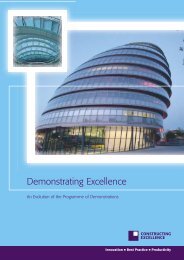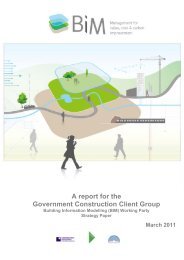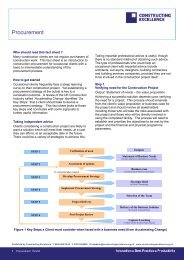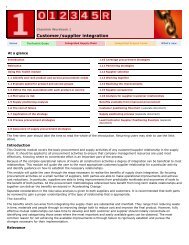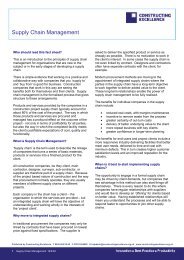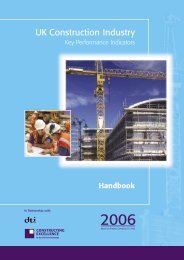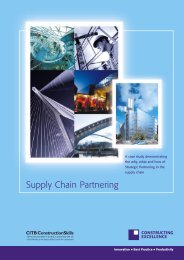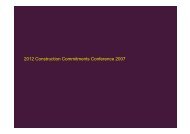Download - Constructing Excellence
Download - Constructing Excellence
Download - Constructing Excellence
You also want an ePaper? Increase the reach of your titles
YUMPU automatically turns print PDFs into web optimized ePapers that Google loves.
UK Construction Industry<br />
Key Performance Indicators<br />
Economic KPIs<br />
Methods of Measurement<br />
In Partnership with<br />
2006<br />
Based on Projects Completed in 2005
IMPORTANT NOTE:<br />
This document gives the methods of measurement for use<br />
with the 2006 UK Construction Industry Economic Key<br />
Performance Indicators.<br />
It should be used in conjunction with the 2006 UK Construction<br />
Industry Key Performance Indicators Handbook and Economic<br />
KPI Wallchart.<br />
In Partnership with<br />
Published by <strong>Constructing</strong> <strong>Excellence</strong><br />
ISBN: 1-905033-17-6<br />
Construction Industry KPI Pack 2006/Housing KPI Toolkit 2006<br />
Electronic Copy<br />
© Crown Copyright 2006<br />
Published under licence from the Controller of Her Majesty's Stationery Office.<br />
Copyright in the typographic arrangement and design vests in the Crown.<br />
This document/publication is value added. If you wish to re-use,<br />
please apply for a Click-Use Licence for value added material at<br />
www.opsi.gov.uk/click-use/system/online/pLogin.asp.<br />
Alternatively applications can be sent to: Office of Public Sector Information,<br />
Information Policy Team, St Clements House, 2-16 Colegate, Norwich NR3 1BQ<br />
Fax: 01603 723000 e-mail: HMSOlicensing@cabinet-office.x.gsi.gov.uk<br />
2006 UK Economic KPIs - All Construction - Methods of Measurement
UK ECONOMIC KPIs<br />
METHODS OF MEASUREMENT<br />
Page No<br />
Key Performance Indicators<br />
4 Client Satisfaction - Product<br />
5 Client Satisfaction - Service<br />
6 Defects<br />
7 Predictability - Cost<br />
-Project<br />
- Design<br />
- Construction<br />
9 Predictability - Time<br />
-Project<br />
- Design<br />
- Construction<br />
11 Profitability<br />
12 Productivity<br />
13 Safety<br />
14 Construction Cost<br />
16 Construction Time<br />
Appendix<br />
19 KPI Data Collection Form<br />
Further Help and Information<br />
25 <strong>Constructing</strong> <strong>Excellence</strong><br />
2006 UK Economic KPIs - All Construction - Methods of Measurement
2<br />
2006 UK Economic KPIs - All Construction - Methods of Measurement
This section contains the methods of measurement for the<br />
following Key Performance Indicators (KPIs).<br />
Client Satisfaction - Product<br />
Client Satisfaction - Service<br />
Defects<br />
Predictability - Cost<br />
Predictability -Time<br />
Profitability<br />
Productivity<br />
Safety<br />
Construction Cost<br />
Construction Time<br />
2006 UK Economic KPIs - All Construction - Methods of Measurement 3
CLIENT SATISFACTION -<br />
PRODUCT<br />
Purpose<br />
To determine the overall level of client satisfaction with the completed product.<br />
Definition<br />
How satisfied the client was with the finished product/facility, using a 1 to 10 scale, where:<br />
10 = Totally satisfied<br />
8 = Mostly satisfied<br />
5/6 = Neither satisfied nor dissatisfied<br />
3 = Mostly dissatisfied<br />
1 = Totally dissatisfied<br />
Method<br />
1 Carry out a survey on completion of the project to determine how satisfied the client was with<br />
the finished product/facility using the 1 to 10 scale above.<br />
2 The Client Satisfaction – Product performance is the client’s rating out of 10.<br />
3 Measure the benchmark score by plotting the performance on the Client Satisfaction – Product<br />
KPI graph.<br />
Example<br />
During a post-project review, the client scores satisfaction with the product at 8 out of 10. Using<br />
the Client Satisfaction - Product graph, the performance score of 8 equates to a benchmark score<br />
of 51%.<br />
Note<br />
This question may be asked as part of a more comprehensive survey or post-project review.<br />
4<br />
2006 UK Economic KPIs - All Construction - Methods of Measurement
CLIENT SATISFACTION -<br />
SERVICE<br />
Purpose<br />
To determine the overall level of client satisfaction with the service of the consultants and main<br />
contractor during the project.<br />
Definition<br />
How satisfied the client was with the service of the consultants and main contractor, using<br />
a 1 to 10 scale, where:<br />
10 = Totally satisfied<br />
8 = Mostly satisfied<br />
5/6 = Neither satisfied nor dissatisfied<br />
3 = Mostly dissatisfied<br />
1 = Totally dissatisfied<br />
Method<br />
1 Carry out a survey on completion of the project to determine how satisfied the client was with<br />
the service of the consultants and main contractor using the 1 to 10 scale above.<br />
2 The Client Satisfaction – Service performance is the client’s rating out of 10.<br />
3 Measure the benchmark score by plotting the performance on the Client Satisfaction – Service<br />
KPI graph.<br />
Example<br />
During a post-project review, the client scores satisfaction with the service of the consultants and<br />
main contractor during the project at 6 out of 10. Using the Client Satisfaction - Service graph, the<br />
performance score of 6 equates to a benchmark score of 12%.<br />
Note<br />
This question may be asked as part of a more comprehensive survey or post-project review.<br />
2006 UK Economic KPIs - All Construction - Methods of Measurement 5
DEFECTS<br />
Purpose<br />
To assess the impact on the client of any defects at the point of handover.<br />
Definition<br />
The condition of the product/facility with respect to defects at the time of handover, using a 1 to 10<br />
scale, where:<br />
10 = Defect-free<br />
8 = Some defects with no significant impact on client<br />
5/6 = Some defects with some impact on client<br />
3 = Major defects with major impact on client<br />
1 = Totally defective<br />
A defect is a fault which adversely affects the appearance or full intended function of the product.<br />
Point of handover is the time when ownership of the product is transferred from the main contractor<br />
to the commissioning client.<br />
Method<br />
1 Carry out a survey on completion of the project to determine the client’s assessment of the<br />
condition of the facility with respect to defects using the 1 to 10 scale above.<br />
2 The Defects performance is the client’s rating out of 10.<br />
3 Measure the benchmark score by plotting the performance on the Defects KPI graph.<br />
Example<br />
During the inspection at the point of handover, a small number of minor defects are discovered<br />
which can be corrected within the first month of use with minor disruption to the facility. The client<br />
scores the project 7 out of 10. Using the Defects graph, the performance score of 7 equates to a<br />
benchmark score of 23%.<br />
Note<br />
This question may be asked as part of a more comprehensive survey or post-project review<br />
6<br />
2006 UK Economic KPIs - All Construction - Methods of Measurement
PREDICTABILITY -<br />
COST<br />
Purpose<br />
To measure the reliability of cost for a project.<br />
Definition<br />
There are three indicators for Predictability - Cost: project, design and construction:<br />
1 Project: actual cost of the combined design and construction process at Available for Use (C)<br />
less the anticipated cost of the combined design and construction process at Commit to<br />
Invest (A), expressed as a percentage of the anticipated cost of the combined design and<br />
construction process at Commit to Invest (A).<br />
2 Design: actual cost of the design process at Available for Use (C) less the anticipated cost of<br />
the design process at Commit to Invest (A), expressed as a percentage of the anticipated cost<br />
of the design process at Commit to Invest (A).<br />
3 Construction: actual cost of the construction process at Available for Use (C) less the<br />
anticipated cost of the construction process at Commit to Construct (B), expressed as a<br />
percentage of the anticipated cost of the construction process at Commit to Construct (B).<br />
Further information on Key Project Stages A, B and C is given in the Handbook in Step 2: Collect Data.<br />
Method<br />
1 Collect the following data for the project:<br />
• anticipated cost of the project at A<br />
• anticipated cost of design at A<br />
• anticipated cost of construction at B<br />
• actual cost of the project at C<br />
• actual cost of design at C<br />
• actual cost of construction at C.<br />
2 Calculate the Predictability – Cost performance, which is the percentage change between the<br />
later and earlier cost, using the appropriate formula:<br />
Performance (%) predictability cost: project =<br />
Actual project cost at C – Anticipated project cost at A<br />
Anticipated project cost at A<br />
x 100<br />
Performance (%) predictability cost: design =<br />
Actual design cost at C – Anticipated design cost at A<br />
Anticipated design cost at A<br />
x 100<br />
Performance (%) predictability cost: construction =<br />
Actual construction cost at C – Anticipated construction cost at B<br />
x 100<br />
Anticipated construction cost at B<br />
3 Measure the benchmark score by plotting the performance on the appropriate line of the<br />
Predictability - Cost KPI graph<br />
2006 UK Economic KPIs - All Construction - Methods of Measurement 7
PREDICTABILITY -<br />
COST (contd.)<br />
Example<br />
Using the following data for a project:<br />
Estimated cost of project at A<br />
Final cost of project at C<br />
= £3,800k<br />
= £3,965k<br />
Tendered cost of design at A = £500k<br />
Final cost of design at C = £490k<br />
Tendered cost of construction at B<br />
Final cost of construction at C<br />
= £3,400k<br />
= £3,475k<br />
Indicator 1<br />
Predictability Cost: Project (A to C) performance =<br />
£3,965k – £3,800k<br />
£3,800k<br />
x 100 = +4%<br />
Using the Predictability - Cost (Project) graph to calculate a benchmark score, +4% equates to a<br />
benchmark score of 40%.<br />
Indicator 2<br />
£490k – £500k<br />
Predictability cost: design (A to C) performance =<br />
x 100 = –2%<br />
£500k<br />
Using the Predictability - Cost (Design) graph to calculate a benchmark score, -2% equates to a<br />
benchmark score of 79%.<br />
Indicator 3<br />
Predictability cost: construction (B to C) performance =<br />
£3,475k – £3,400k<br />
£3,400k<br />
x 100 = +2%<br />
Using the Predictability - Cost (Construction) graph to calculate a benchmark score, +2% equates to<br />
a benchmark score of 42%.<br />
Notes<br />
The anticipated design cost and construction cost should, where possible be the amounts of the<br />
respective accepted quotations/tenders, agreed target cost or agreed maximum price.<br />
The actual design cost and construction cost should where possible be the amounts of the<br />
respective final accounts.<br />
If these are not available the best available estimate should be used.<br />
Construction cost should include all work in the main contract and should only include site clearance<br />
and enabling work when this is included in the main contract.<br />
Those wishing to achieve on cost delivery as opposed to cost savings should use the above method<br />
but calculate the benchmark score using the Variance Cost Graph contained in the Additional<br />
Performance Indicators book in the KPI Pack.<br />
8<br />
2006 UK Economic KPIs - All Construction - Methods of Measurement
PREDICTABILITY -<br />
TIME<br />
Purpose<br />
To measure the reliability of time for a project.<br />
Definition<br />
There are three indicators for Predictability - Time: project, design and construction:<br />
1 Project: actual duration of the combined design and construction process at Available for Use<br />
(C) less the anticipated duration of the combined design and construction process at Commit<br />
to Invest (A), expressed as a percentage of the anticipated duration of the combined design<br />
and construction process at Commit to Invest (A).<br />
2 Design: actual duration of the design process at Commit to Construct (B) less the anticipated<br />
duration of the design process at Commit to Invest (A), expressed as a percentage of the<br />
anticipated duration of the design process at Commit to Invest (A).<br />
3 Construction: actual duration of the construction process at Available for Use (C) less the<br />
anticipated duration of the construction process at Commit to Construct (B), expressed as a<br />
percentage of the anticipated duration of the construction process at Commit to Construct (B).<br />
Further information on Key Project Stages A, B and C is given in the Handbook in Step 2: Collect Data.<br />
Method<br />
1 Collect the following data for the project:<br />
• anticipated duration of the project at A<br />
• anticipated duration of design at A<br />
• anticipated duration of construction at B<br />
• actual duration of design at B<br />
• actual duration of the project at C<br />
• actual duration of construction at C.<br />
2 Calculate the Predictability – Time performance which is the percentage change between the<br />
anticipated and actual duration, using the appropriate formula:<br />
Performance (%) predictability time: project =<br />
Actual project time at C – Anticipated project time at A<br />
Anticipated project time at A<br />
x 100<br />
Performance (%) predictability time: design =<br />
Actual design time at B – Anticipated design time at A<br />
Anticipated design time at A<br />
x 100<br />
Performance (%) predictability time: construction =<br />
Actual construction time at C – Anticipated construction time at B<br />
Anticipated construction time at B<br />
x 100<br />
3 Measure the benchmark score by plotting the performance on the appropriate line of the<br />
Predictability - Time KPI graph<br />
2006 UK Economic KPIs - All Construction - Methods of Measurement 9
PREDICTABILITY -<br />
TIME (contd.)<br />
Example<br />
Using the following data for a project:<br />
Estimated project time at A<br />
Actual project time at B<br />
Design contract period at A<br />
Actual design time at B<br />
Construction contract period at B<br />
Actual construction period at C<br />
= 104 weeks<br />
= 109 weeks<br />
= 60 weeks<br />
= 68 weeks<br />
= 56 weeks<br />
= 60 weeks<br />
Indicator 1<br />
109 weeks – 104 weeks<br />
Predictability time: Project (A to C) performance =<br />
x 100 = +5%<br />
104 weeks<br />
Using the Predictability - Time (Project) graph to calculate a benchmark score, +5% equates to a<br />
benchmark score of 40%.<br />
Indicator 2<br />
68 weeks – 60 weeks<br />
Predictability Time: Design (A to B) performance =<br />
x 100 = +13%<br />
60 weeks<br />
Using the Predictability - Time (Design) graph to calculate a benchmark score, +13% equates to a<br />
benchmark score of 33%.<br />
Indicator 3<br />
60 weeks – 56 weeks<br />
Predictability Time: Construction (B to C) performance =<br />
x 100 = +7%<br />
56 weeks<br />
Using the Predictability - Time (Construction) graph to calculate a benchmark score, +7% equates to<br />
a benchmark score of 31%.<br />
Notes<br />
The anticipated design time and construction time should, where possible be the amount of time<br />
stated in the respective accepted quotations/tenders.<br />
The actual design time and construction time should where possible be the amount of time elapsed<br />
between commence on site and completion of the project.<br />
If these are not available the best estimate should be used.<br />
Construction time should include all work in the main contract and should only include site clearance<br />
and enabling work when this is included in the main contract.<br />
Those wishing to achieve on time delivery as opposed to time savings should use the above method<br />
but calculate the benchmark score using the Variance Time Graph contained in the Additional<br />
Performance Indicators Book in the KPI Pack.<br />
10<br />
2006 UK Economic KPIs - All Construction - Methods of Measurement
PROFITABILITY<br />
Purpose<br />
To measure the profitability of a construction company before tax and interest.<br />
Definition<br />
Company profit before tax and interest as a percentage of sales.<br />
Method<br />
1 Collect the following information for a company for a complete year:<br />
• value of profit before tax and interest<br />
• value of sales.<br />
2 Calculate the Profitability performance using the formula:<br />
Performance (%) profitability =<br />
Profit before tax and interest<br />
Value of sales<br />
x 100<br />
3 Measure the benchmark score by plotting the performance on the Profitability KPI graph.<br />
Example<br />
Using the following data for a company:<br />
Profit before tax and interest<br />
= £2.10m<br />
Value of sales = £30m<br />
Profitability performance (%) =<br />
£2.10m<br />
£30m<br />
x 100 = +7.0%<br />
Using the Profitability graph to calculate a benchmark score, +7.0% equates to a benchmark score<br />
of 47%.<br />
Note<br />
Organisations wishing to calculate profitability at a project rather than company level should refer to<br />
the method given in the Handbook under Further Help and Information.<br />
2006 UK Economic KPIs - All Construction - Methods of Measurement 11
PRODUCTIVITY<br />
Purpose<br />
To determine the value-added per employee of a construction company.<br />
Definition<br />
Company value added per employee per year (£).<br />
Method<br />
1 Collect the following information for a company for a complete year:<br />
• value of sales<br />
• total value of sub-contracted services<br />
• total value of goods supplied<br />
• the average number of full-time equivalent employees.<br />
Two people each working half-time make one full-time equivalent employee.<br />
2 Calculate the Productivity performance using the formula:<br />
Performance (£) =<br />
Value of sales in the year - total value of sub-contracted services - total value of goods supplied<br />
Average number of full-time equivalent employees in the year<br />
3 Measure the benchmark score by plotting the performance on the Productivity KPI graph.<br />
Example<br />
Using the following data for a company:<br />
Value of sales in the year = £30m<br />
Total value of sub-contracted services = £10m<br />
Total value of goods supplied = £12m<br />
Average number of full-time equivalent employees in the year = 280<br />
£30m – £10m – £12m<br />
Productivity performance = = £28,571<br />
280<br />
Using the Productivity graph to calculate a benchmark score, £28,571 equates to a benchmark score<br />
of 33%.<br />
Note<br />
Organisations wishing to calculate Productivity at a project rather than company level should refer to<br />
the method given in the Handbook under Further Help and Information.<br />
12<br />
2006 UK Economic KPIs - All Construction - Methods of Measurement
SAFETY<br />
Purpose<br />
To measure a company’s safety performance.<br />
Definition<br />
Reportable accidents per 100,000 employed by the company per year – the Accident Incidence<br />
Rate (AIR).<br />
Reportable accidents are defined by HSE as fatalities, major injuries, and over 3 day accidents to<br />
employees, self-employed and members of the public.<br />
Two people each working half time for the year are equivalent to one person employed.<br />
Method<br />
1 Collect the following data for the company for a complete year:<br />
• the number of reportable accidents. On a properly managed site, details of all accidents will<br />
be recorded in the accident book<br />
• the average number employed by the company, including self-employed<br />
and sub-contractors.<br />
2 Calculate the Safety performance using the formula:<br />
Performance (AIR) safety =<br />
Number of reportable accidents in the year<br />
Average number employed in the year including self-employed and sub-contractors<br />
x 100,000<br />
3 Measure the benchmark score by plotting the performance on the ‘All Companies’ or the<br />
‘Companies with turnover greater than £10m’ line on the Safety KPI graph as appropriate.<br />
Example<br />
A company with an annual turnover greater than £10m collects the following data on its safety<br />
performance:<br />
Number of reportable accidents in the year = 5<br />
Average number directly employed in the year = 72<br />
Average number of sub-contractors employed in the year = 558<br />
Safety performance (AIR) =<br />
5<br />
72 + 558<br />
x 100,000 = 794<br />
Using the ‘Companies with Turnover Greater than £10m’ line on the Safety graph to calculate<br />
a benchmark score, the AIR of 794 equates to a benchmark score of 61%.<br />
Notes<br />
The Health and Safety Executive estimated that only 50% of reportable accidents are actually reported.<br />
The Safety KPI graph has been adjusted to take account of this.<br />
AIR makes no allowance for variations such as part-time work or overtime. Many organisations measure<br />
accidents per 100,000 hours worked (the Accident Frequency Rate, or AFR), which takes into account<br />
variations in working hours. A method of converting AIR to AFR is given in the Handbook under Further<br />
Help and Information.<br />
Companies wishing to calculate Safety at a project rather than company level should use the formula<br />
given in the Handbook under Further Help and Information.<br />
2006 UK Economic KPIs - All Construction - Methods of Measurement 13
CONSTRUCTION COST<br />
Purpose<br />
To measure the change in real cost of construction from one year to the next.<br />
If two identical structures were built in successive years, the Construction Cost KPI shows how much<br />
the construction costs have changed in the year.<br />
It is unusual to have two identical structures, so data from similar projects has to be normalised to<br />
enable comparison to be made. Normalisation is the statistical method of removing the effects of<br />
specification, location, function, size and inflation.<br />
Definition<br />
The normalised construction cost of a project in the current year, less the construction cost of a<br />
similar project one year earlier, expressed as a percentage of the construction cost of the similar<br />
project one year earlier.<br />
Method<br />
There are two methods of measuring Construction Cost. Method 1 is a simple ‘rule of thumb’ which<br />
may be used as a quick and approximate method. Method 2 is more complex, more reliable, and<br />
most accurately follows the method used to produce the published KPI graphs.<br />
Method 1<br />
(‘rule of<br />
thumb’)<br />
The following ‘rule of thumb’ method of measurement may be used in place of the more complex<br />
‘accurate method’ (Method 2). The tender price referred to below can be either for the whole facility<br />
or can be a unit rate (e.g. cost per m 2 of the facility).<br />
1 Collect the following data:<br />
• tender price for the current project (TP1)<br />
• tender price for comparison project (one year earlier) (TP2).<br />
2 Calculate the following for the current project:<br />
• the percentage adjustment for specification differences from the previous year’s<br />
project (Spec %)<br />
• the percentage adjustment for location difference from the previous year’s project (Loc %)<br />
• the percentage adjustment for resource cost inflation since the previous year’s project (Inf %).<br />
3 Calculate the Construction Cost performance using the formula:<br />
(((TP1 +/- Spec %) +/- Loc %) +/- Inf %) – TP2<br />
Performance (%) =<br />
TP2<br />
x 100<br />
4 Measure the benchmark score by plotting the performance on the Construction Cost KPI graph.<br />
Example<br />
(Method 1)<br />
Calculation of Construction Cost using data from two office building projects.<br />
Current project:<br />
Tender Price = £930/ m 2<br />
Specification<br />
Location<br />
Resource Cost Inflation<br />
= Calculated at 5% higher than comparison project<br />
= Calculated at 8% higher than comparison project<br />
= Calculated at 3% higher than comparison project<br />
Comparison project (constructed a year earlier):<br />
Tender Price = £805/ m 2<br />
Construction Cost performance =<br />
(((£930 – 5%) – 8%) – 3%) – £805<br />
£805<br />
x 100 = –2.0%<br />
14<br />
2006 UK Economic KPIs - All Construction - Methods of Measurement
CONSTRUCTION COST (contd.)<br />
Example<br />
(Method 1)<br />
(contd.)<br />
Method 2<br />
(accurate)<br />
Using the Construction Cost graph to calculate a benchmark score, -2% equates to a benchmark<br />
score of 53%.<br />
1 Collect the following data for the both the current project and the comparison project<br />
(one year earlier):<br />
• project tender price index. This may be obtained from DTI or BCIS.<br />
• the location factor (if applicable) from tables published by DTI or BCIS<br />
• the resource cost index from tables published by DTI or BCIS<br />
• the size factor (where available) from tables published by DTI or BCIS<br />
The data needed to normalise a project is published quarterly by DTI and BCIS (see the Further<br />
Help and Information section of the Handbook).<br />
2 Calculate the capital cost index (CCI) for both projects using the formula:<br />
Project Capital Cost Index =<br />
(CCI)<br />
Tender Price Index<br />
Location Factor x Function Factor x Size Factor<br />
x<br />
100<br />
Resource Cost Index<br />
3 Calculate the Construction Cost performance using the formula:<br />
Performance (%) construction cost =<br />
Current Project CCI – Previous Project CCI<br />
Previous Project CCI<br />
x 100<br />
4 Measure the benchmark score by plotting the performance on the Construction Cost KPI graph.<br />
Example<br />
(Method 2)<br />
Calculation of a project Capital Cost Index for a £20m new build road construction project in the south<br />
east of England (whose calculated tender price index is 110 in the first quarter of the current year) using<br />
adjustment factors contained in the tables published in DTI’s Quarterly Building Price and Cost Indices:<br />
Tender Price Index = 110 (calculated)<br />
Location Factor = 1.09 (from Table 7.4)<br />
Function Factor = 0.99 (from Table 8.2)<br />
Size Factor = 0.92 (from Table 9.2)<br />
Resource Cost Index = 108 (from Table 12.2)<br />
Capital Cost Index =<br />
110<br />
1.09 x 0.99 x 0.92<br />
x<br />
100<br />
108 = 103<br />
If an equivalent calculation, carried out for a similar project in the previous year, had provided a Project<br />
Capital Cost Index of 105, then the Construction Cost performance (change in real cost of construction)<br />
between these two projects would be:<br />
103 – 105<br />
Construction Cost performance = x 100 = –1.9%<br />
105<br />
Using the Construction Cost graph to calculate a benchmark score, -1.9% equates to a benchmark<br />
score of 53%.<br />
2006 UK Economic KPIs - All Construction - Methods of Measurement<br />
15
CONSTRUCTION TIME<br />
Purpose<br />
To measure the change in construction time from one year to the next.<br />
If two identical structures were built in successive years, the Construction Time KPI shows how much<br />
the construction times have changed in the year.<br />
It is unusual to have two identical structures, so data from similar projects has to be normalised to<br />
enable comparison to be made. Normalisation is the statistical method of removing the effects of<br />
specification, location, function, size and inflation.<br />
Definition<br />
The normalised time to construct a project in the current year, less the time to construct a similar<br />
project one year earlier, expressed as a percentage of the time to construct a similar project one<br />
year earlier.<br />
Method<br />
There are two methods of measuring Construction Time. Method 1 is a simple ‘rule of thumb’ which<br />
may be used as a quick and approximate method. Method 2 is more complex, more reliable, and most<br />
accurately follows the method used to produce the published KPI graphs.<br />
Method 1<br />
(‘rule of<br />
thumb’)<br />
1 Collect the following data:<br />
• contract period for the current project (CP1)<br />
• contract period for the comparison project (one year earlier) (CP2).<br />
2 Calculate the following for the current project:<br />
• the percentage adjustment that needs to be made to time due to specification differences<br />
from the previous year’s project (Spec %)<br />
• the percentage adjustment that needs to be made to time due to the size difference from<br />
the previous year’s project (Size %).<br />
3 Calculate the Construction Time performance using the formula:<br />
Performance (%) =<br />
((CP1 +/- Spec %) +/- Size %) – CP2<br />
CP2<br />
x 100<br />
4 Measure the benchmark score by plotting the performance on the Construction Time KPI graph.<br />
Example<br />
(Method 1)<br />
Calculation of Construction Time using data from two office building projects.<br />
Current project:<br />
Contract period<br />
Specification<br />
Size<br />
= 67 weeks<br />
= Calculated at 8% higher than the comparison project<br />
= Calculated at 10% smaller than the comparison project<br />
Comparison project (constructed a year earlier):<br />
Contract period<br />
Construction Time performance =<br />
= 71 weeks<br />
((67 weeks – 8%) + 10%) – 71 weeks<br />
71 weeks<br />
x 100 = –4.5%<br />
Using the Construction Time graph to calculate a benchmark score, -4.5% equates to a benchmark<br />
score of 58%.<br />
16<br />
2006 UK Economic KPIs - All Construction - Methods of Measurement
CONSTRUCTION TIME (contd.)<br />
Method 2<br />
(accurate)<br />
1 Collect the following data for the both the current project and the comparison project<br />
(one year earlier):<br />
• contract sum (CS)<br />
• contract period (CP)<br />
• the location factor (LF), if applicable, from tables published by DTI or BCIS<br />
• the function factor (FF), if applicable, from tables published by DTI or BCIS<br />
• the size factor (SF), where available, from tables published by DTI or BCIS<br />
• project tender price index (TPI). This may be obtained from DTI or BCIS.<br />
The data needed to normalise a project is published quarterly by DTI and BCIS (see the Further<br />
Help and Information section of the Handbook).<br />
2 Calculate the Construction Time Factor (CTF) for both projects using the formula:<br />
CTF =<br />
CP ÷<br />
CS (£000s) 100<br />
(<br />
x<br />
)<br />
LF x FF x SF<br />
3 Calculate the Construction Time performance using the formula:<br />
TPI<br />
Current Project CTF – Comparison Project CTF<br />
Performance (%) = x 100<br />
Comparison Project CTF<br />
4 Measure the benchmark score by plotting the performance on the Construction Time KPI graph.<br />
Example<br />
(Method 2)<br />
Calculation of a project Construction Time Factor for a new factory project built in the first quarter of<br />
the current year in the south east of England using the tables published in DTI’s Quarterly Building<br />
Price and Cost Indices:<br />
Contract Period<br />
= 15 months<br />
Contract Sum<br />
= £5,000k<br />
Location Factor = 1.03 (from Table 2.4)<br />
Function Factor = 1.00 (from Table 3.4)<br />
Size Factor<br />
= Not applicable<br />
Tender Price Index = 108 (from Table 1.3)<br />
( )<br />
5,000 100<br />
Construction Time Factor = 15 ÷ x = 0.00334<br />
1.03 x 1.00 x NA 108<br />
If a similar calculation, carried out for an equivalent project in the previous year, had provided a<br />
Construction Time Factor 0.00347, then the Construction Time performance (change in time for<br />
construction) between these two projects would be:<br />
0.00334 – 0.00347<br />
Construction Time performance = x 100 = –3.7%<br />
0.00347<br />
Using the Construction Time graph to calculate a benchmark score, -3.7% equates to a benchmark<br />
score of 44%.<br />
2006 UK Economic KPIs - All Construction - Methods of Measurement 17
18<br />
2006 UK Economic KPIs - All Construction - Methods of Measurement
ECONOMIC KPI<br />
DATA COLLECTION FORM (Page 1 of 5)<br />
Company/Project Name<br />
Data collected by<br />
Date<br />
KPI Data Result<br />
Client Satisfaction How satisfied was the client with the quality of the finished<br />
– Product product, using a 1-10 scale:<br />
Totally<br />
dissatisfied<br />
Mostly<br />
dissatisfied<br />
Neither satisfied<br />
nor dissatisfied<br />
Mostly<br />
satisfied<br />
Totally<br />
satisfied<br />
1 2 3 4 5 6 7 8 9 10<br />
Client Satisfaction How satisfied was the client with the service provided by the<br />
– Service consultants and main contractor, using a 1-10 scale:<br />
Totally<br />
dissatisfied<br />
Mostly<br />
dissatisfied<br />
Neither satisfied<br />
nor dissatisfied<br />
Mostly<br />
satisfied<br />
Totally<br />
satisfied<br />
1 2 3 4 5 6 7 8 9 10<br />
Defects<br />
What was the condition of the facility with respect to defects at the<br />
time of handover, using a 1-10 scale:<br />
Totally<br />
defective<br />
Major defects,<br />
major impact<br />
on Client<br />
Some defects, with<br />
some impact<br />
on Client<br />
Some defects,<br />
with no significant<br />
impact on Client<br />
Defect free<br />
1 2 3 4 5 6 7 8 9 10<br />
Predictability<br />
What was the estimated cost of design and construction at Commit to Invest<br />
– Cost (Project) (i.e. when the project was originally sanctioned)?<br />
£______________________(A)<br />
What was the final cost of design and construction at Available for Use?<br />
£______________________(C)<br />
Calculate<br />
£C________ - £A________<br />
£A________<br />
x 100<br />
+ –<br />
%<br />
2006 UK Economic KPIs - All Construction - Methods of Measurement 19
ECONOMIC KPI<br />
DATA COLLECTION FORM (Page 2 of 5)<br />
KPI Data Result<br />
Predictability What was the estimated cost of design at Commit to Invest<br />
– Cost (Design) (i.e. when the project was originally sanctioned)?<br />
£______________________(A)<br />
What was the final cost of design at Available for Use?<br />
£______________________(C)<br />
Calculate<br />
£C________ - £A________<br />
£A________<br />
x 100<br />
+ –<br />
%<br />
Predictability What was the estimated cost of construction at Commit to Construct<br />
– Cost (e.g. the tender sum)?<br />
(Construction)<br />
£______________________(B)<br />
What was the final cost of construction at Available for Use<br />
(e.g. the contractor’s final account)?<br />
£______________________(C)<br />
Calculate<br />
£C________ - £B________<br />
£B________<br />
x 100<br />
+ –<br />
%<br />
Predictability What was the estimated duration of the design and construction at<br />
– Time (Project) Commit to Invest (i.e. when the project was originally sanctioned)?<br />
Weeks_________________(A)<br />
What was the actual duration of the design and construction at<br />
Available for Use?<br />
Weeks_________________(C)<br />
Calculate<br />
C________ - A________<br />
A________<br />
x 100<br />
+ –<br />
%<br />
Predictability What was the estimated duration of the design phase at Commit to<br />
– Time (Design) Invest (i.e. when the project was originally sanctioned)?<br />
Weeks_________________(A)<br />
What was the actual duration of the design phase at Commit to<br />
Construct (i.e. when construction actually commenced)?<br />
Weeks_________________(B)<br />
Calculate<br />
B________ - A________<br />
A________<br />
x 100<br />
+ –<br />
%<br />
20<br />
2006 UK Economic KPIs - All Construction - Methods of Measurement
ECONOMIC KPI<br />
DATA COLLECTION FORM (Page 3 of 5)<br />
KPI Data Result<br />
Predictability What was the estimated duration of the construction phase at<br />
– Time Commit to Construct (e.g. the contract period)?<br />
(Construction)<br />
Weeks_________________(B)<br />
What was the actual duration of the construction period Available<br />
for Use?<br />
Weeks_________________(C)<br />
Calculate<br />
C________ - B________<br />
B________<br />
x 100<br />
+ –<br />
%<br />
Safety<br />
(Accident<br />
Incidence Rate)<br />
How many reportable accidents have you had in the past year<br />
(i.e. fatalities, major injuries, and over 3 day accidents to employees,<br />
your sub-contractors and members of the public)?<br />
Number________________(A)<br />
What was the average number of full-time equivalent employees you<br />
had in the year? (2 people each working half-time make 1 full-time<br />
equivalent)<br />
Number________________(B)<br />
How many sub-contractors did you employ on average during the year?<br />
Number________________(C)<br />
Calculate<br />
A________<br />
B________ +C________<br />
x 100,000<br />
Productivity<br />
What was the value of sales last year?<br />
£________________(A)<br />
What was the total value of sub-contracted services last year?<br />
£________________(B)<br />
What was the total value of goods supplied last year?<br />
£________________(C)<br />
What was the number of full-time equivalent employees last year?<br />
£________________(D)<br />
Calculate<br />
£A_______ -£B_______ -£C_______<br />
D_______<br />
£<br />
2006 UK Economic KPIs - All Construction - Methods of Measurement 21
ECONOMIC KPI<br />
DATA COLLECTION FORM (Page 4 of 5)<br />
KPI Data Result<br />
Profitability<br />
What was the profit before interest and tax last year?<br />
£______________________(A)<br />
What was the value of sales last year?<br />
£______________________(B)<br />
Calculate:<br />
£A________<br />
£B________<br />
x 100<br />
+ –<br />
%<br />
Construction Cost<br />
The calculations for Construction Cost are complex – refer to the<br />
Methods of Measurement.<br />
Select a typical project completed a year ago. What was the<br />
tender price?<br />
£______________________(A)<br />
Select a similar project completed recently. What was the tender price?<br />
£______________________(B)<br />
What adjustment needs to be applied to the most recent project to<br />
allow for specification differences between them?<br />
Plus/Minus___________%(C)<br />
(Note: If specification this year is higher, the correction should be<br />
minus to bring this year in line with last year).<br />
What adjustment needs to be applied to allow for location<br />
differences between them?<br />
Plus/Minus___________%(D)<br />
(Note: If location this year is more expensive, the correction should<br />
be minus to bring this year in line with last year).<br />
What adjustment needs to be made to allow for inflation between<br />
them?<br />
Plus/Minus___________%(E)<br />
(Note: If inflation this year is higher, the correction should be minus<br />
to bring this year in line with last year).<br />
Calculate: (((B______ +C______) +D______) +E______) – A______<br />
A______<br />
x 100<br />
+ –<br />
%<br />
22<br />
2006 UK Economic KPIs - All Construction - Methods of Measurement
ECONOMIC KPI<br />
DATA COLLECTION FORM (Page 5 of 5)<br />
KPI Data Result<br />
Construction Time<br />
The calculations for Construction Time are complex – refer to the<br />
Methods of Measurement.<br />
Select a typical project completed a year ago. What was the<br />
contract period?<br />
______________________(A)<br />
Select a similar project completed recently. What was the contract period?<br />
£______________________(B)<br />
What adjustment needs to be applied to the most recent project to<br />
allow for specification differences between them?<br />
Plus/Minus___________%(C)<br />
(Note: If specification this year is higher, the correction should be<br />
minus to bring this year in line with last year).<br />
What adjustment needs to be applied to allow for location<br />
differences between them?<br />
Plus/Minus___________%(D)<br />
(Note: If inflation this year is higher, the correction should be minus<br />
to bring this year in line with last year).<br />
Calculate: (((B______ +/-C)______+/-D)______) – A______<br />
A______<br />
x 100%<br />
+ –<br />
%<br />
Now you have obtained your performance results, calculate your<br />
benchmark scores and plot a radar chart.<br />
2006 UK Economic KPIs - All Construction - Methods of Measurement 23
24<br />
2006 UK Economic KPIs - All Construction - Methods of Measurement
CONSTRUCTING EXCELLENCE<br />
<strong>Constructing</strong> <strong>Excellence</strong> provides a range of services to help implement KPIs:<br />
Helpdesk<br />
A direct point of contact to answer initial enquiries<br />
about KPIs. Tel 0845 605 55 56<br />
The KPI Pack<br />
A source of comprehensive information for<br />
organisations wishing to use KPIs.<br />
The Housing KPI Toolkit<br />
Vital information for using KPIs in the housing sector.<br />
KPIZone<br />
A website dedicated to KPIs. Visit www.kpizone.com<br />
for free information on KPIs and benchmarking clubs.<br />
KPIZone also has a subscription service from which you<br />
can download the information contained in the KPI Pack<br />
and Housing KPI Toolkit.<br />
KPI Masterclasses<br />
An introduction to the benefits and use of the<br />
Construction Industry KPIs. Each Masterclass<br />
explores the importance of measuring performance<br />
with the help of practical examples, a step by step<br />
guide to their use, and presentations by organisations<br />
that have successfully implemented KPIs.<br />
Website<br />
An extensive database of best practice activities,<br />
information and resources is available on<br />
www.constructingexcellence.org.uk .<br />
At <strong>Constructing</strong> <strong>Excellence</strong> we bring distinctive value to our customers’ businesses<br />
through six core activities:<br />
Innovation and Research:<br />
Members shape and take part in <strong>Constructing</strong><br />
<strong>Excellence</strong>’s research programme, from major action<br />
research projects to working groups and confidential<br />
learning clubs.<br />
Measurement and Diagnostics:<br />
<strong>Constructing</strong> <strong>Excellence</strong> has led the way in industry<br />
performance measurement, with diagnostic tools<br />
central to its activities. Members receive:<br />
• Complimentary KPI pack<br />
• Complimentary introductory Explorer<br />
Interactive TM business diagnostic session<br />
• 20% discount on KPI Masterclasses.<br />
Tailored Services for Business<br />
Improvement:<br />
<strong>Constructing</strong> <strong>Excellence</strong> is able to offer members<br />
consultancy tailored to their business requirements. This<br />
service includes free or discounted access to <strong>Constructing</strong><br />
<strong>Excellence</strong> publications, and discounts on facilitation and<br />
mentoring services and conferences.<br />
Business-to-Business Networks:<br />
Existing members see real benefits in these networks,<br />
meeting with other like minded individuals and<br />
companies, building relationships, sharing best practice<br />
and developing business contacts.<br />
Showcasing and Exemplars:<br />
One of the key benefits of membership is being able to<br />
demonstrate participation to key stakeholders such as<br />
customers, employees, suppliers and investors.<br />
<strong>Constructing</strong> <strong>Excellence</strong> provides members:<br />
• Opportunities to showcase projects<br />
• Opportunities to share and learn from<br />
members’ exemplars<br />
• Invitations to speak as an acknowledged industry<br />
leader at <strong>Constructing</strong> <strong>Excellence</strong> events.<br />
Leadership and Influence:<br />
<strong>Constructing</strong> <strong>Excellence</strong> works closely with government,<br />
strategic partners, firms and influencer organisations to<br />
shape the future of the sector. Members have the chance<br />
to take an active role in influencing Government priorities<br />
and to have input into the formation of future policy at<br />
regular forums and conferences.<br />
CONSTRUCTING EXCELLENCE<br />
Warwick House, 25 Buckingham Palace Road, London, SW1W 0PP<br />
0845 605 55 56<br />
(calls charged at local rate)<br />
email: helpdesk@constructingexcellence.org.uk<br />
www.constructingexcellence.org.uk<br />
2006 UK Economic KPIs - All Construction - Methods of Measurement 25
CONSTRUCTING EXCELLENCE<br />
Warwick House<br />
25 Buckingham Palace Road<br />
London<br />
SW1W 0PP<br />
Tel: 0845 605 55 56<br />
Fax: 020 7592 1101<br />
E-mail: helpdesk@constructingexcellence.org.uk<br />
Website: www.constructingexcellence.org.uk<br />
In Partnership with<br />
Published by <strong>Constructing</strong> <strong>Excellence</strong><br />
ISBN: 1-905033-17-6<br />
Construction Industry KPI Pack 2006/Housing KPI Toolkit 2006<br />
Electronic Copy





